© Chris Woodland
As the years roll by many customs, tools and words that were once in daily use fade from normal life, living on only in the minds of those that have experienced their presence. Eventually that which was once an integral part of every day existence is known only to the occasional historian or folklorist.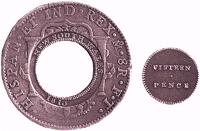
Those of a mature age are aware of items that much younger people have had no experience of except, perhaps, as a misty, ill-defined picture from the past that has been related by members of a dwindling, older generation. (Life-style changes came to country people much later than it did to their city counterparts: efficient sewerage systems, electricity, telephones, television and the like took ages to slowly snake out across the continent until now only the most isolated still have to generate their own electricity and rely on space-age telephonic services.)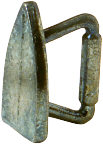
The younger generation(s) are, understandably, oblivious to once universal family home appliances: the copper for doing the (usually) weekly wash and often providing hot water for bathing; the charcoal or flat iron that was heated on the fuel stove to press the many shirts, blouses, dresses, trousers, handkerchiefs and other garments (in days long before wash-and-wear clothes were available, though probably dreamed of) as well as other household materials. Today, pan toilets, which were delivered smelling strongly of phenol and taken away by the ‘nightman’, would place people with no experience in their use in a decidedly anxious situation. The local grocer weighing out the sugar, biscuits, dates and other foodstuffs into brown paper bags would have many people of today suffering a culture shock, as they would when their order was delivered by a boy on a bicycle with the groceries wobbling about in the wire frame in front of the handlebars. The green grocer would not allow the customer to handle any of the fruit or vegetables before buying, unlike today when patrons serve themselves to keep costs down.
In the back country before 1960 it was common to see the many drovers plying a trade that had changed little since the very early days of the colony. Until roaring road trains carried the stock of the outback to the ‘inside’ markets and stations most drovers still used pack-saddles or wagonettes to carry their swags, tucker and gear, (though it must be acknowledged that rubber tyres for wagonettes were very popular), when moving the almost legendary mobs from camp to camp across the country. No more does the traveller see the once numerous brush yards, or brake, to house sheep on night camps. Now rotted away, these three-sided yards were erected from fallen mulga by the overlanders, the fourth side consisted of the camp and dogs chained at appropriate distances. Nor are seen the many remains of gidgee campfires that had burnt down to dust-sized ashes, dotting the outback stock routes. These basic hearths showed where the drovers had boiled their quarts, cooked with their camp ovens and warmed themselves after a chilling nightwatch around a mob of resting cattle that had been driven from far western and northern runs whose names have been immortalised by Ogilvie, Morant and the like.
The old saying that nothing ever stays the same is a very true one indeed, and currency is no exception to that adage.
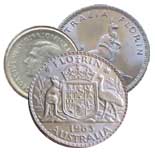 Just a few years ago the subject of Australian currency developed with three friends as we chatted over a glass or two of red wine around a glorious log fire in a rustic country restaurant. I was amazed that none of my companions (one male and two females) had heard of the pre-decimal currency dollar of my earlier days, nor of the much earlier colonial ‘holey dollar’. On reflection it is significant that they were all just a few years younger than I and that two had come from middle-class backgrounds, at least one of whom had attended a private school, while the other came from a migrant family where English was their second language. The male was, and remains, a very learned person in Australian folklore and history. I came from a so-called working class background.
Just a few years ago the subject of Australian currency developed with three friends as we chatted over a glass or two of red wine around a glorious log fire in a rustic country restaurant. I was amazed that none of my companions (one male and two females) had heard of the pre-decimal currency dollar of my earlier days, nor of the much earlier colonial ‘holey dollar’. On reflection it is significant that they were all just a few years younger than I and that two had come from middle-class backgrounds, at least one of whom had attended a private school, while the other came from a migrant family where English was their second language. The male was, and remains, a very learned person in Australian folklore and history. I came from a so-called working class background.
The dollar I knew from my earliest days until decimal currency replaced our previous pounds, shillings and pence system in 1966, had the value of five shillings, known in the idiom as ‘five bob’. My father was the first person to make me aware of this term which related to any number of coins that totalled five shillings (the equivalent of today’s 50 cents). At that time there was no dollar coin as such, it was a value. To my understanding the expression was not universally used throughout society; I can never recall a woman using the term – colloquialisms were avoided by the fairer sex. It seemed to be mainly used by the males of the so-called blue-collar working class. As such it was generally confined to the environments they normally inhabited.
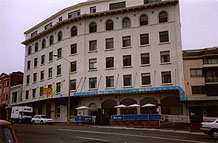
As a lad in the early 1950s, selling papers outside the Hotel Astra at Bondi, it was not unusual to hear dollar mentioned in transactions, but probably the most consistent use of the word was by the punters. The betting fraternity would always be having a ‘dollar outright on such-and-such,’ or a ‘dollar each way on (another hopeful)’. It appeared to me that the most common bet with the bookies, whether it be on the track or with the illegal S.P.s was a dollar – it seemed the standard bet. I am informed by others more familiar with ‘two up’ that the pre-1966 dollar was also a common betting value with that form of gambling.
The use of the dollar as currency in Australia goes back to when the young colony was suffering from many growing pains, of which coinage was one.
Often short of coins herself, England’s colonies suffered even more so. Queen Anne proclaimed in 1704 that captured Spanish dollars and their fractional parts were officially accepted currency in the ‘British North American Colonies’. In 1788 Governor Phillip arrived with soldiers and convicts of the First Fleet to take up the new British colony of New South Wales. The money he brought with him soon dissipated over the next few years in buying supplies from merchant ships arriving from America and India. By 1796 the barter method was firmly established, soon to be followed by a fraudulent-prone IOU system. The members of John Macarther’s New South Wales Corps received their pay by the more reliable method of promissory notes. Of course it is well known that with Phillip’s return to England in 1792, the new colony being without a governor until Hunter’s arrival in 1795, the New South Wales Corps took control of all merchandise arriving in the colony, selling to the settlers at profit. Soon to become known as the Rum Corps, Macarther’s soldiers also took control of rum (the general term for spirits) and, following Phillips departure, made rum the currency for wages. Australia’s first bushranger, Black Caesar, had a reward of 22 gallons (100 litres) of rum offered for his capture.
Currencies other than Spanish dollars such as Dutch ducats, Portuguese johannas and some Indian pagodas were traded in the new colony of New South Wales but they left the shores almost as soon as they arrived. There was to be little assistance from England as she too was short of coins, having to stamp George III’s head over that of the Spanish king on captured Spanish dollars for her own coinage.
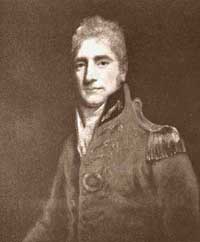
To prevent the re-exportation of coins from Trinidad in the British West Indies a proclamation was issued in June 1811 permitting the circulation of a cut dollar and the centre, or dump, from the cut dollar. This cut dollar was to become known as the holey dollar and was valued at nine shillings and the dump at one shilling. This practice of producing two coins by punching one from the original probably came to the attention of the enterprising Scot Lachlan Macquarie, who became governor of the colony of New South Wales in 1810.
In 1810 Macquarie proclaimed that there would be severe penalties for those using other than ‘Stirling Money’ because of the destructive issue of what were known as ‘Currency Notes’. This action gave birth to the terms Currency Lads and Currency Lasses as opposed to Stirling: the colonial currency as well as the native born being inferior to the ‘real thing’, the Stirling currency and the English born.
Possibly at Macquarie’s request, a special shipment of 40 000 Spanish dollars arrived in New South Wales in 1810 from Bengal. A proclamation dated 1 July 1813 read, in part:
And whereas His Excellency the Governor hath therefore thought proper to direct that a small Circular piece of Silver shall be struck out of the Centre of every such dollar, which together with the remaining part of every such dollar is intended to be issued and circulated at the value and under the regulations hereinafter described.
Continuing, the proclamation explained that the smaller piece of ‘Silver’ (the dump) would have the impression of a crown with ‘New South Wales’ and the date ‘1813’ stamped below on one side, with the value ‘Fifteen Pence’ stamped on the other. The larger piece of silver had the words ‘Five Shillings’ and a branch of laurel stamped on one side with ‘New South Wales’ and ‘1813’ on the reverse side. The outer rim of the dump and both sides of the inner rim of the holey dollar were described as ‘grained’, that is they had been stamped with a straight knurl-type impression around those surfaces. Of the holey dollar the proclamation said that it:
… shall be current within the territory, and every part thereof, for the sum of Five shillings of lawful Money of the Untied Kingdom of Great Britain and Ireland, of English value and Currency.
The holey dollar was the colony’s legal tender until 1829 when England solved her coin production problems and sent adequate supplies to her colonies. During that time the dollar became an integral part of the language. Subscription to the Sydney Gazette in 1822 was altered from ‘fifty-two shillings stirling per annum’ to twelve dollars. On 5 January 1826 a subscriber to the same publication offered a reward of ten dollars for the return of his kangaroo dog.
holey dollarWhile the holey dollar brought stability to the day to day commerce of New South Wales, and its shape prevented it from leaving the colony’s shores in any numbers, it was not without some threat. On 5 May 1821 the Bank of New South Wales published a notice which said, in part: ‘A Number of Bad Dollars and Dumps having been lately offered in Payment at the Bank of New South Wales …’. The warning noted that many of these counterfeits could be detected by the date stamped on the coin – instead of 1813 they had been incorrectly stamped ‘1381’!
From the period of the original captured Spanish dollar and then through the stamping of the holey dollar in 1813 till it ceased to be legal tender in 1829, the term lived on as the value of five shillings until the introduction of the decimal currency on 14 February 1966. Many years after it had been taken out of circulation the town of Ulladulla on the south coast of New South Wales was still known in the vernacular as ‘Holey Dollar’. Oxford scholar, being rhyming slang for dollar, could have originated in England by those colourful manipulators of the English language the cockneys, and brought to these shores by a migrant or convict. Perhaps one of the latter coined the term after their arrival here – the answer lies somewhere in the past.
As the introduction of decimal currency drew near many firms insisted that their employees attend ‘educational’ sessions so that they would be familiar with the new currency. The day following an evening’s decimal currency workshop, a garage attendant that I knew was asked by a customer to put a dollar’s worth of petrol in his car. There was a disagreement when the attendant put an amount of ten shillings (the equivalent of the soon-to-be-issued decimal dollar) in the tank instead of the traditional dollar’s worth which was equal to five shillings. My acquaintance said that it would not have happened had he been asked for the same amount of petrol on the preceding day and laid the blame on his attendance at the ‘propaganda session’ of the previous night! No doubt there were many similar interesting stories circulating on this theme at the time.
Just two examples in Australian poetry of the use of the term dollar, when no such coin existed, are to be found in Lawson’s Booth’s Drum (1915):
Till they sent their prettiest lassies – and they broke our centre there.
So that, moderately sober, we could stand to hear them sing –
And we’d chaff their Testifiers, and throw quids into the ring.
(Never less than bobs or ‘dollars’ – sometimes quids into the ring.)
and in C J Dennis’s poem Hitched which appears in the Sentimental Bloke collection for which Lawson wrote the foreword in 1915:
At last Doreen an’ me we gits away,
An’ leaves ’em doin’ nothin’ to the scran.
(We’re honey-moonin’ down beside the Bay.)
I gives a ‘arf a dollar to the man
Wot drives the cab; an’ like two kids we ran …
Australians have been using the term ‘dollar’ since the days of early white settlement: beginning with the Spanish dollar, through the short years of the holey dollar, then the 137 years of the holey dollar’s value being used for five shillings worth of coins, until the present time. It is incredible that the term used for the value of five shillings lived for 137 years in the language of many Australians, though there was no accompanying coin.
_____________________________________________________________________
About the author
Chris Woodland has had a life-long interest in Australian folklore. While his hair was still brown he worked on outback cattle and sheep stations and maintains those earlier associations.
For many years he has made field recordings (housed in the National Library of Australia) of many bush personalities, including (Aboriginal and white) drovers, shearers, isolated women, poets, songwriters singers, veteran soldiers etc. Over the years Chris has been an active member of the Sydney Bush Music Club and Monaro Folk Music Society. He has been a presenter over many years on community radio 2XX in Canberra.
He retired to a few acres near Termeil on the South Coast of NSW in 2002 and then a few kilometres away to Bawley Point in 2015. For several years he ran a course called Wallaby Stew at the Milton-Ulladulla University of the Third Age.
Chris produced a book of historic photos with text on the old gold town of Araluen for the Braidwood & District Historical Society, which has sold well. It was published in 2015, followed by another book published in the same year titled Billy the Blackfella from Bourke, relating the fascinating life of his deceased mate.
Chris now spends most of his time with grandchildren and singing and playing with friends. His group is called AusSongs.
References & Further Reading
- The Coin Book – Australain History Through Coins
by Michael Rabbitt, Hake & Ironmonger, 1993. - A Dictionary of Australian Colloquialisms by G A Wilkes, Fontana/Collins, reprint 1985.
- An Account of the Coins, Coinages, and Currency of Australasia by Coleman P Hyman, Govt Printer, Sydney, 1893.

